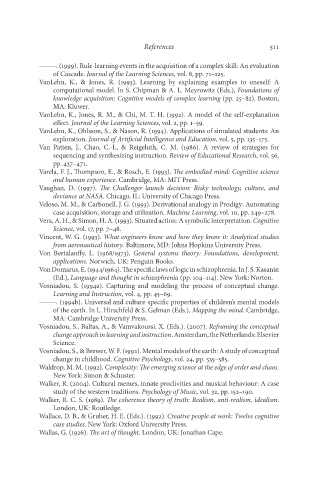Page 528 - Deep Learning
P. 528
References 511
———. (1999). Rule-learning events in the acquisition of a complex skill: An evaluation
of Cascade. Journal of the Learning Sciences, vol. 8, pp. 71–125.
VanLehn, K., & Jones, R. (1993). Learning by explaining examples to oneself: A
computational model. In S. Chipman & A. L. Meyrowitz (Eds.), Foundations of
knowledge acquisition: Cognitive models of complex learning (pp. 25–82). Boston,
MA: Kluwer.
VanLehn, K., Jones, R. M., & Chi, M. T. H. (1992). A model of the self-explanation
effect. Journal of the Learning Sciences, vol. 2, pp. 1–59.
VanLehn, K., Ohlsson, S., & Nason, R. (1994). Applications of simulated students: An
exploration. Journal of Artificial Intelligence and Education, vol. 5, pp. 135–175.
Van Patten, J., Chao, C.-I., & Reigeluth, C. M. (1986). A review of strategies for
sequencing and synthesizing instruction. Review of Educational Research, vol. 56,
pp. 437–471.
Varela, F. J., Thompson, E., & Rosch, E. (1993). The embodied mind: Cognitive science
and human experience. Cambridge, MA: MIT Press.
Vaughan, D. (1997). The Challenger launch decision: Risky technology, culture, and
deviance at NASA. Chicago, IL: University of Chicago Press.
Veloso, M. M., & Carbonell, J. G. (1993). Derivational analogy in Prodigy: Automating
case acquisition, storage and utilization. Machine Learning, vol. 10, pp. 249–278.
Vera, A. H., & Simon, H. A. (1993). Situated action: A symbolic interpretation. Cognitive
Science, vol. 17, pp. 7–48.
Vincent, W. G. (1993). What engineers know and how they know it: Analytical studies
from aeronautical history. Baltimore, MD: Johns Hopkins University Press.
Von Bertalanffy, L. (1968/1973). General systems theory: Foundations, development,
applications. Norwich, UK: Penguin Books.
Von Domarus, E. (1944/1964). The specific laws of logic in schizophrenia. In J. S. Kasanin
(Ed.), Language and thought in schizophrenia (pp. 104–114). New York: Norton.
Vosniadou, S. (1994a). Capturing and modeling the process of conceptual change.
Learning and Instruction, vol. 4, pp. 45–69.
———. (1994b). Universal and culture-specific properties of children’s mental models
of the earth. In L. Hirschfeld & S. Gelman (Eds.), Mapping the mind. Cambridge,
MA: Cambridge University Press.
Vosniadou, S., Baltas, A., & Vamvakoussi, X. (Eds.). (2007). Reframing the conceptual
change approach in learning and instruction. Amsterdam, the Netherlands: Elsevier
Science.
Vosniadou, S., & Brewer, W. F. (1992). Mental models of the earth: A study of conceptual
change in childhood. Cognitive Psychology, vol. 24, pp. 535–585.
Waldrop, M. M. (1992). Complexity: The emerging science at the edge of order and chaos.
New York: Simon & Schuster.
Walker, R. (2004). Cultural memes, innate proclivities and musical behaviour: A case
study of the western traditions. Psychology of Music, vol. 32, pp. 152–190.
Walker, R. C. S. (1989). The coherence theory of truth: Realism, anti-realism, idealism.
London, UK: Routledge.
Wallace, D. B., & Gruber, H. E. (Eds.). (1992). Creative people at work: Twelve cognitive
case studies. New York: Oxford University Press.
Wallas, G. (1926). The art of thought. London, UK: Jonathan Cape.

